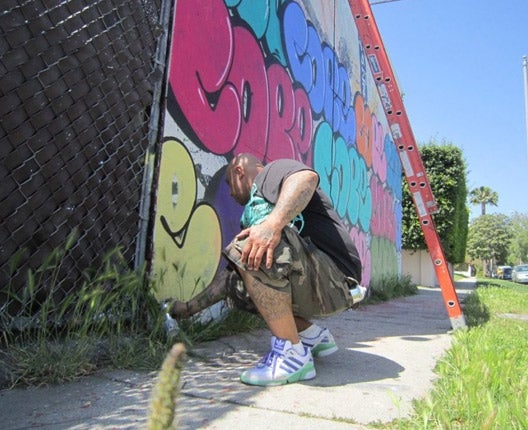They called it "art in the streets" and that is exactly what they got. The Museum of Contemporary Art (Moca) in Los Angeles finds itself at loggerheads with the city's police force, amid allegations that its latest blockbuster exhibition has led to a spike in spray can-fuelled vandalism.
A week after it opened America's largest major show devoted entirely to graffiti, Moca has been accused of turning the Little Tokyo neighbourhood surrounding its Geffen Contemporary Gallery into a "magnet" for petty criminals. As a result, the success of an exhibition which is attracting huge crowds to admire work by Banksy, Os Gemeos, Shepard Fairey and others is being overshadowed by controversy. In addition to being accused of celebrating and inspiring vandalism, the gallery is also being forced to remove graffiti from nearby streets.
Moca's PR department was also yesterday asked to explain why at least four of the artists invited to Los Angeles to contribute pieces for the exhibition devoted a portion of their stay to doing what comes naturally: illegally defacing some of the city's most prominent walls.
Three well-known "taggers" in the Moca show – Barry McGee, Steve Powers, and Todd James (who is better known as Reas) – this week posted videos online that showed them taking spray cans to a wall in Hollywood. A fourth, the French artist Space Invader, who features heavily in the film Exit Through the Gift Shop, was arrested while attempting to affix one of his signature mosaics to a Los Angeles wall.
Police claim that in addition to bringing these "criminals" to their city, Moca's exhibition has inspired dozens of taggers who are not featured in the exhibition (but want to piggyback the attention it has received) to deface urban furniture in the neighbourhood around the gallery.
"The exhibit kind of glorifies graffiti," said Sergeant Augie Pando, of the Los Angeles County Sheriff's Department, who helps oversee his force's anti-graffiti campaign. "It puts taggers on front street."
A colleague told yesterday's Los Angeles Times: "We respect the rights to have an art exhibition, but we demand the security of other people's property... if you want to be an artist, buy a canvas."
Moca has so far refused to comment. But it highlights some of the inconsistencies raised by elevating a criminal activity to the status of mainstream art. "These artists are good enough for the city to put their work in one of its major cultural institutions. But if they do it on the streets, where the art is meant to be seen, the city will have them arrested," Sebastian Buck, who writes the blog Unurth, said.
Other pundits noted that the police's efforts to crack down on street art come at a time when the city is easing regulations to make it easier to place commercial-advertising billboards in public spaces. "It's crazy. If you stand by any mural, you will see people stopping to take photographs of it. Street art makes the city a better place," said Greg Linton, the editor of Melrose & Fairfax, the biggest street-art website in Los Angeles. "Tourists like it, and most residents like it."

Join our commenting forum
Join thought-provoking conversations, follow other Independent readers and see their replies
Comments